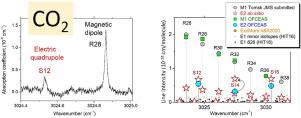Journal of Quantitative Spectroscopy and Radiative Transfer ( IF 2.3 ) Pub Date : 2021-02-07 , DOI: 10.1016/j.jqsrt.2021.107558 Hélène Fleurbaey , Roberto Grilli , Didier Mondelain , Samir Kassi , Andrey Yachmenev , Sergei N. Yurchenko , Alain Campargue

|
The recent detections of electric-quadrupole (E2) transitions in water vapor and magnetic-dipole (M1) transitions in carbon dioxide have opened a new field in molecular spectroscopy. While in their present status, the spectroscopic databases provide only electric-dipole (E1) transitions for polyatomic molecules (H2O, CO2, N2O, CH4, O3…), the possible impact of weak E2 and M1 bands to the modeling of the Earth and planetary atmospheres has to be addressed. This is especially important in the case of carbon dioxide for which E2 and M1 bands may be located in spectral windows of weak E1 absorption. In the present work, a high sensitivity absorption spectrum of CO2 is recorded by Optical-Feedback-Cavity Enhanced Absorption Spectroscopy (OFCEAS) in the 3.3 µm transparency window of carbon dioxide. The studied spectral interval corresponds to the region where M1 transitions of the ν2+ν3 band of carbon dioxide were recently identified in the spectrum of the Martian atmosphere. Here, both M1 and E2 transitions of the ν2+ν3 band are detected by OFCEAS. Using recent ab initio calculations of the E2 spectrum of 12C16O2, intensity measurements of five M1 lines and three E2 lines allow us to disentangle the M1 and E2 contributions. Indeed, E2 intensity values (on the order of a few 10–29 cm/molecule) are found in reasonable agreement with ab initio calculations while the intensity of the M1 lines (including an E2 contribution) agree very well with recent very long path measurements by Fourier Transform spectroscopy. We thus conclude that both E2 and M1 transitions should be systematically incorporated in the CO2 line list provided by spectroscopic databases.
中文翻译:

到ν电四极和磁偶极子的贡献2 +ν 3接近3.3微米的二氧化碳的带
最近检测到的水蒸气中的四极电子(E2)跃迁和二氧化碳中的磁偶极(M1)跃迁为分子光谱学开辟了一个新领域。在目前的状态下,光谱数据库仅提供多原子分子(H 2 O,CO 2,N 2 O,CH 4,O 3 …)的电偶极(E1)跃迁,弱的E2和M1谱带的可能影响必须解决地球和行星大气的建模问题。这对于二氧化碳(E2和M1谱带可能位于弱E1吸收的光谱窗口中)的情况尤为重要。在目前的工作中,CO 2的高灵敏度吸收光谱通过光反馈腔增强吸收光谱(OFCEAS)在二氧化碳的3.3微米透明窗口中记录。所研究的光谱间隔对应于其中ν的M1的过渡区域2 +ν 3二氧化碳的带在火星大气的频谱最近鉴定。这里,ν的M1和E2跃迁2 +ν 3带由OFCEAS检测。使用最近对12 C 16 O 2的E2光谱进行从头计算,对5条M1线和3条E2线的强度测量使我们可以解开M1和E2的贡献。实际上,E2强度值(大约为10 –29 分子/分子)与从头算计算合理地发现,而M1谱线的强度(包括E2贡献)与傅立叶变换光谱法最近进行的很长距离的测量非常吻合。因此,我们得出结论,E2和M1跃迁均应系统地纳入光谱数据库提供的CO 2线列表中。











































 京公网安备 11010802027423号
京公网安备 11010802027423号